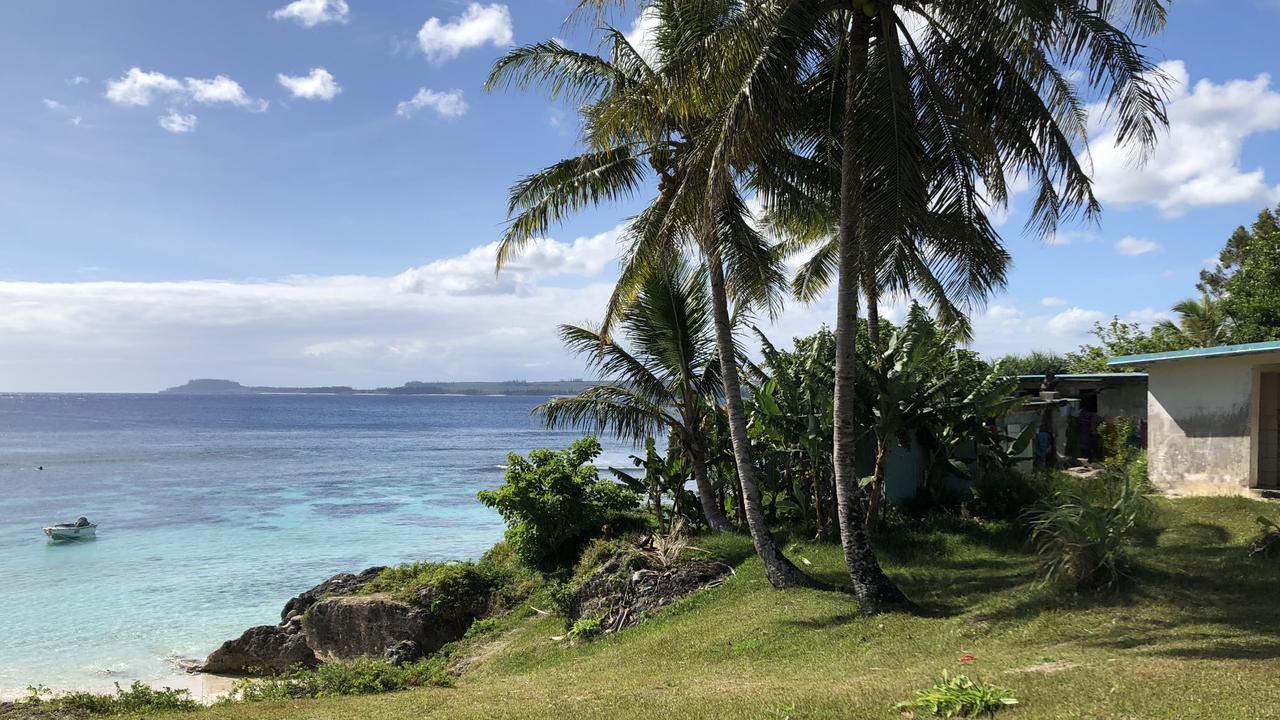Small and sweet Costa Rica
TINY Costa Rica, on the Central American isthmus, is packed with appeal, from cloud forests to quiet beaches and extraordinary wildlife, writes Carolina Miranda.

TINY Costa Rica, on the Central American isthmus, is packed with appeal, from cloud forests to quiet beaches and extraordinary wildlife, writes Carolina Miranda.
-- Your trip mapped out
EVERY corner of this mountainous little country is worthy of exploration from the remote jungle outposts of the Osa Peninsula to the laid-back surf town of sunny Nosara.
1 Puerto Viejo de Talamanca
Best for food
The flavours of Spain, Central America and the Caribbean combine into one glorious whole in this village with a reputation for good eating.
2 La Fortuna
Best for adventure
If you've ever wanted to abseil down by a waterfall or watch someone else take the plunge instead this volcanic landscape is just the ticket.
3 Monteverde
Best for forest walks
The cloud forests of Costa Rica provide a unique environment full of hidden surprises, and one that can be explored on foot, too.
4 Nosara
Best for beaches
In a country known for balancing the needs of development with nature conservation, this stretch of Pacific coast is a treasure.
5 Osa Peninsula
Best for wildlife
The black-throated trogon is but one of the bird species that make their home in a jungle habitat unchanged since the days of Sir Francis Drake.
-- Puerto Viejo De Talamanca
Best for food
Distance into your trip: 214km
From the capital San Jose, a three-hour drive east will bring you to Puerto Viejo de Talamanca on the Caribbean coast.
In a bright kitchen, Elena Brown flits between a pan, where strips of yellow plantain hiss, and a potful of bubbling sauce. Elena has spent much of her life practising the traditional cooking of the Caribbean.
"My mum had 14 children," she says with a toothy grin. "So everybody had to take a turn."
These days she cooks at her namesake restaurant in the seaside village.
For generations, Costa Rica's Caribbean coast has brought together English-speaking settlers from Jamaica, indigenous groups from the Talamanca Mountains and Spanish Creoles living in the country since Christopher Columbus dropped anchor nearby in 1502.
By the 20th century, the area had developed a distinct culture: locals spoke Mekatelyu, a rapid-fire Creole dialect based on West Indian English; Calypso musicians wrote ballads about banana companies and malevolent women; and the fusion of people and ingredients turned food into one of the area's enduring symbols.
The cuisine mixes island spice with Central American heartiness. One of the most beloved dishes is the steamy soup rondon, an exquisite coconut milk concoction studded with cassava, green bananas, fish and shrimp, and laced with blazing scotch bonnet chilli peppers.
Puerto Viejo has grown into a popular seaside destination but the area holds on to its roots. Radio sets play contemporary calypso songs, smallholders farm cacao (cocoa) and on a wooden terrace fringed with hot-pink tropical flowers Elena serves up the recipes her mother taught her, plus a few others picked up along the way.
"I love it when people eat my food," she says.
"When people come, they aren't just eating. They're tasting the Caribbean."
--Further Information
Artisanal fishing trips and tours to cacao farms are available from ateccr.org (half-day tours from $40).
-- Where to eat
Grab a table at Restaurante Elena Brown, on the eastern road out of town (dishes from $8).
-- Where to stay
Namuwoki Lodge
Located 6.5km east of Puerto Viejo in Playa Chiquita, intimate Namuwoki has eight whitewashed bungalows accented in tropical hardwoods and cosy outdoor sitting areas. There is also a swimming pool for lounging by, a whirlpool bath and a restaurant that serves excellent grilled seafood (from $118; namuwoki.com).
-- La Fortuna
- Best for adventure
Distance into your trip: 720km
From Puerto Viejo, the road heads north then east, and into the foothills of the Tilaran Mountains, in a 4 1/2-hour drive.
For centuries, no one in La Fortuna knew that a volcano loomed over their town. Its last major eruption occurred around 1400, and it then fell into a long, deep sleep.
By the time the 20th century arrived, the farmers who lived in the area referred to the towering peak simply as Cerro Arenal Arenal Hill. The misnomer didn't become apparent until the 1960s, when the "hill" suddenly rumbled into life. Its name has since been upgraded to Volcan Arenal.
Sergio Rodriguez, a naturalist guide who grew up in the region and has lived in La Fortuna for the past 12 years, has studied the volcano and climbed it hundreds of times. The eruptions, he says, can feel otherworldly "like an earthquake followed by the sound of someone turning on the world's biggest transformer".
As he makes his way through the scrub, he tells Arenal's story. La Fortuna sits in the foothills of the Tilaran Mountains and, for much of the 20th century, was known as a cattle-ranching hub.
Yet when Arenal began putting on its regular pyrotechnic displays in the late 1960s, the area drew the attention of international vulcanologists as well as thrill-seeking travellers.
Seeing lava flows today depends on the volcano's daily moods, and a lack of clouds around the summit. However, Arenal's activities have also turned La Fortuna into a centre for outdoor adventure, with trails that range from wheelchair-friendly to a four-hour hike up to the crater lake of Arenal's dormant neighbour, Volcan Chato.
To the east, the churning rapids of the Balsa and Toro rivers deliver heart-pumping white-water rafting. To the south, in a narrow mountain canyon, hikers abseil down cliffs and waterfalls, and to the west, visitors soak away aches and pains earned in more energetic pursuits in a series of steamy hot springs.
Standing at the edge of El Salto a deep natural swimming hole on the southern edge of the village Sergio says the area was attracting local explorers back in the early 1900s, when people came to scale the steep Arenal and camp in the warm, plant-filled crater at the top.
"Some folks used to call it the Cerro de Los Arrepentidos the Mountain of Regret," the gregarious Sergio says with a chuckle, "because so many people who started the climb would regret it about halfway up and then just walk back down."
In recent years, the volcano has mostly become quieter. The last significant flare-ups were in the 1990s, but traces of the behemoth's blistering past can still be found all over Parque Nacional Volcan Arenal, where short trails wind through lava fields studded with coal-coloured igneous rocks.
Today, walkers are obliged to stop before the summit, because occasionally Arenal groans and rumbles.Further InformatIon For guided adventures, see desafiocostarica.com
- Where to eat
This is cattle country, so you can't go wrong with the delicious grilled steak at Don Rufino (steaks from $24; donrufino.com).
- Where to stay
Nayara hotel, spa & gardens
Six kilometres west of town and surrounded by tropical rainforest, each of the 50 wood-lined casitas (little houses) at this tranquil hillside retreat comes with a volcano view. The resort has a restaurant, pool and a spa (from $282; arenalnayara.com).
-- Monteverde
- Best for forest walks
Distance into your trip: 812km
From La Fortuna, the road loops around Lake Arenal into cloudy peaks.
"The cloud forest is an interminable source of surprises," says Eduardo Venegas Castro as he walks beneath the trees. He has spent most of his adult life in Monteverde, having served as a director of two of the area's most prominent cloud forest parks.
Today, he leads hikes around the mountains, armed with a spotting scope, a camera, binoculars and a small birdwatchers book.
Straddling the continental divide, the Monteverde area is a conservation zone preserving cloud forests where evergreen vines and lichens cling to every available surface, and jewel-coloured quetzals and hummingbirds flit between the trees.
Hiking through the Santa Elena Cloud Forest Reserve, it is easy to understand Eduardo's sense of mystery. At more than 1650m above sea level, the reserve marinates in cloud cover.
Moody light conditions are accompanied by a running soundtrack of drips and trickles, occasionally punctuated by the startling, synthesiser-like cry of the three-wattled bellbird.
The vegetation seems intent on covering everything in sight: massive plants sprout leaves the size of patio umbrellas and the vines of the strangler fig curl around wild avocado trees.
Everywhere there are bright bursts of orchids, some of them no bigger than the head of a pin. Santa Elena is home to roughly 600 of Costa Rica's 1400 or more orchid species.
Eduardo smiles as he looks out into the trees where a curling mass of green disappears into the mist. The forest does not reveal its secrets easily.
- Further Information
Half-day tours are available from flordelistours.com (from $47 a person, including park fees).
- Where to eat
On the road to Monteverde, cosy Chimera serves excellent tapas (from $4.70).
- Where to stay
-- El Establo
On the site of a former cattle ranch, this large, ski-chalet-style hotel has 155 spacious wood-and-stone rooms, each with a balcony or terrace.
It's possible to see all the way to the coast on a clear day, and the heated hilltop pool is ideal for a sunset dip (from $220; elestablo.com).
-- Nosara
- Best for beaches
Distance into your trip: 973km
Descend from Monteverde to the Pan-American Highway, before heading west for three hours to the Nicoya Peninsula. The road to Nosara is a bouncy one. A shaded, dirt lane crawls between rice plantations and herds of brahman cattle before it takes up its course alongside the gleaming Pacific.
Here, an endless expanse of white sand and warm water is fringed by sea grape trees and capped on either end by a rocky point.
"It's a simple life," says Nosara native Juan, nicknamed "Surfo" to differentiate him from all the other men named Juan. With his sun-bleached hair and deep tan, he looks like an extra in a Californian surf flick. "You can run around without shoes or a shirt. It's very informal," he says.
There are countless seaside communities in Costa Rica, but few that have retained their character like Nosara, which sits in the middle of the Nicoya Peninsula's long, craggy coast.
Though the area has grown more popular in the past couple of decades, strong development laws keep Nosara decidedly low-key: construction isn't allowed along the shoreline, which means that the sand is backed by vegetation, not blocky resort hotels.
The few businesses are independent and scattered around the forest like Juan's surf shop and school, which lies on a narrow, tree-lined lane about 100m from the beach.
Juan is a surf addict who has taught all ages how to ride boards. "This beach isn't just for one type of person," he says. "It's for everybody."
He points out how the long beach break makes it ideal for all beachgoers, providing three different kinds of wave. Upfront popular with scampering children, local mutts and paddling grown-ups clutching cocktails baby breakers spill out on to the sand.
In the middle, novice surfers and boogie boarders attempt to catch their first rides. Out in the deep water, advanced surfers bob around on the swell, lying in wait for the perfect curl.
Other nearby beaches offer different incentives to explore. A few kilometres to the north is Ostional, a protected nesting site for olive ridley sea turtles, which arrive in their hundreds every full moon.
Immediately to the south is Playa Garza, a wide bay with gentle waves, where fishermen can still be found on the beach tending to their nets.
Even farther south along the coast are the adjacent beaches of Carrillo and Samara, both lined with swaying palms. The latter bustles with village life, including some excellent beachside grills.
Still, it can be difficult to peel away from Nosara's perfect warm waters and glistening white sands fringed with green forest.
"This is as a beach should be," Surfo says. "It's a place where you can always feel the nature all around you."Further Information Surf lessons and board rentals can be found at surfocostarica.com (lessons from $47).
Where to eat Giardino Tropicale, on the main road in Nosara, offers an Italian-inspired menu of pizzas cooked in a brick oven, pasta dishes and salads, plus a daily selection of seafood (pizzas from $9.40; giardinotropicale.com).
- Where to stay
L'Acqua Viva Resort & Spa
Located off the main road, this dramatic 35-room inn takes its design cues from the soaring lines of Balinese architecture. Decorative touches include wood floors, bamboo doors, roomy sandstone bathrooms and bright textiles (from $205; lacquaviva.com).
-- Osa Peninsula
- Best for wildlife
Distance into your trip: 1370km
A 3 1/2-hour drive east leads to the city of San Jose. From here, take a one-hour flight south to Bahia Drake.
In the spring of 1579, Francis Drake landed on the shores of Costa Rica's Osa peninsula. He needed a protected spot to make repairs to his ship without drawing the attention of the Spanish fleet, having recently relieved a galleon of its treasure.
Here, he found just what he was looking for: a chain of isolated bays fronted by a vast tangle of rainforest. As well as providing an excellent place to hide, it had plenty of wildlife. In his journals, he records great quantities of fish, "alargartoes" and "munckeyes" fish, crocodiles and monkeys are still to be found here.
The views that Drake admired from his ship the Golden Hind have changed little. The coast remains a riot of steamy rainforest, and the main way of getting around Bahia Drake the minute Osa settlement named for the swashbuckler is still by boat or foot.
The peninsula now contains the last remaining stand of coastal Pacific rainforest in Central America, protecting the habitats of elusive jungle species such as the jaguar and puma, plus a roll call of other exotic characters from squirrel monkeys and sloths to silky anteaters and poison-dart frogs.
"You'll see animals here that you simply can't find anywhere else," says Orgel Chavarria, who was raised on the Osa.
He now helps run the westernmost ranger station of the Corcovado National Park at San Pedrillo, where herons patrol a tidal pool out the front: "This is a treasure."
A web of footpaths connects one end of Corcovado to the other, through a carpet of lowland rainforest and past estuaries where Drake's "alargartoes" sleep off their lunch.
In the upper reaches of the forest canopy, clusters of macaws cackle loudly.
Spotting some of the jungle's shyer creatures requires patience slaty-tailed trogon birds blend into the tangle of tree branches, and gangs of croaking frogs come out only at night.
"This is not a zoo," says Orgel with a gentle smile.
"The animals are constantly on the move. You'll see them, but you have to be quiet and be willing to wait. Sometimes, nature decides when she is ready to come to you."
- Further Information
For an overview of the Corcovado and a colourful wildlife gallery, see osaconservation.org.
- Where to eat and stay
Casa Corcovado
Set on a reserve bordering the national park, Casa Corcovado has bright bungalows with screened-in porches, two bars, several swimming pools and a dining hall serving local specialities.
Rates include meals and a guided hike (three-night packages from $790 a person; casacorcovado.com)



